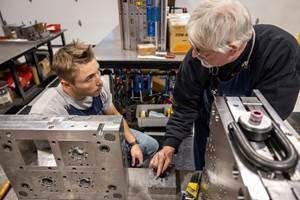Awareness of manufacturing careers has increased over the past few years, and at Westminster Tool, we believe that community involvement is the key to this positive trend. Most of our success with awareness and recruitment has been a result of hosting community events that encourage engagement across the industry and within our company.
Here are six best practices for hosting a successful community event in your area.
Diversify Your Audience
It is important to note that there are many audiences that need to know about manufacturing careers. Moreover, it is important to realize that it is not just students. Your community includes students and school programs, manufacturing peers, teachers, parents and general community members who may be looking for a career change.
While the diversity of these groups may seem overwhelming, the processes and best practices for engaging each of them at an event are very similar to one another. Here are a few ways to engage these groups through a company-hosted event.
- Community open house. An open house provides an opportunity to invite everyone in the community to tour your organization, learn about what you do and see how the inside of a manufacturing facility looks. Many people are not aware of what items are made right in their backyard nor the technology that is used to make these items, which often are essential to our day-to-day lives.
- Tours for local schools and school programs. Schools are constantly seeking ways to educate students on different career paths and to help them see real-life applications of the concepts that they teach. Inviting students to tour not only contributes to their education and awareness of manufacturing, but also is a great way to interact with the up-and-coming talent pool.
- Tours for local manufacturers. Collaboration is a powerful tool that businesses can leverage. Simply by inviting other manufacturers to tour your organization, you can help to share insight into best practices, recent accomplishments and areas in which you excel. For example, if you recently completed a Kaizen that made it possible for you to increase throughput in a previous bottleneck area, invite a company to visit to understand the process so that they can apply a similar technique to their bottleneck. When we help each other improve, we enhance the development of manufacturing within our community.
It is important to note that there are many audiences that need to know about manufacturing careers. Moreover, it is important to realize that it is not just students.
Know Your Audience
It is important to know the audience that you are inviting into your company. Identifying the knowledge level of your audience members will help you set appropriate talking points that will engage and excite them and not confuse or bore them. Be sure to share this information with anyone who is going to be speaking with or presenting to your guests.
For instance, your approach to explaining the EDM process should differ vastly between talking to a group that has never heard of an electrode and talking to a group that is familiar with the idea of manufacturing the inverse of a shape to get the desired geometry. Your speakers are most likely industry experts who consider “spark gap” common vernacular, so they may need a reminder on speaking in more simplistic terms to express their points.
Be Mindful of Timing
Timing is key to produce an engaging event successfully. Be sure to give people plenty of notice regarding the event so that they can make appropriate arrangements with minimal interruption to their schedule. Again, it is important to consider your audience. If you want to have your local school system send a notice home with students, you most likely will need to get approval from the superintendent first. Build extra time into your schedule to accommodate for these approvals the first time you host an event.
You should be sure to map out the timing of the event carefully as well. For starters, ensure that you know how much time you are going to spend for the entire tour, and be sure to lay out the flow and timing. Attendees should have a specific amount of time at each tour station, and the timing should be equal for each stop, enabling groups to move consistently through the shop to prevent a backup from forming.
Be Engaging
Now that you have the community in your doors, it is important to engage them so that you leave a lasting impact. By knowing the members of your audience, you will have a better idea of how to engage them. A key way to do this is to explain not only what your product is, but how those in the audience may interact with the product in their lives. Using props, like a sample of the finished product, is a great way to captivate non-auditory learners.
Another way to make your event engaging is to ask questions and create an environment where attendees are encouraged to ask questions and start a discussion. At Westminster Tool, we typically do this at the start of a tour by saying “No question is stupid!” We also make a point to say that we are there to help them with whatever questions they have.
Now that you have the community in your doors, it is important to engage them so that they leave impacted.
Collect Data
Collecting information about who attends, including contact details, will help you to plan accordingly. Your approach will change if you have five attendees versus 50. It is also an opportunity to create a database of people who may be interested in future events that you host. At Westminster Tool, we have used resources like MailChimp and Eventbrite to help us host some of our larger events. We also have a database of interested community members to drive participation and spread the word.
Collecting data on what works and what does not work is essential. For example, if showing an end product only seemed to distract a group of students, make a note of it for future events so as not to repeat the mistake.
Provide Impactful Giveaways
Hosting events is a great opportunity for you to promote your organization and manufacturing. Send guests away with brochures that explain how someone can apply for a position, job applications for an interested attendee, flyers for local manufacturing education programs and business cards for anyone interested in shadowing for a future job or who merely has more questions.
When hosting an event for your peers, connect them with the most appropriate person within your team to help them tackle the challenge they are facing or hand out a flyer regarding other ways to get involved with a community manufacturing group. The key is not to let the enthusiasm you created end once they step out the door.
About the Contributor
Kylee Carbone is director of Talent Development for Westminster Tool and a 2018 MoldMaking Technology EAB member.
Related Content
How to Foster Innovation Through a Culture of Education, Mentoring
Dynamic Tool Corp. shares its strategy for building a team with the right attitude and aptitude to deliver innovation that meets customer expectations.
Read MoreThe Role of Social Media in Manufacturing
Charles Daniels CFO of Wepco Plastics shares insights on the role of social media in manufacturing, how to improve the “business” side of a small mold shop and continually developing culture.
Read MoreConfronting the Mold Design Talent Drought
Recently, I reposted on LinkedIn the results of an informal survey we conducted, which revealed a shortage of skilled mold designers. It quickly gained a lot of traction. Given the response, I thought I'd summarize the feedback and keep the conversation going.
Read MoreEden Tool and Eden Manufacturing: A Story of Resilience, Growth and Innovation
This critical parts manufacturer, founded on solid tooling fundamentals, didn’t get derailed with the unexpected passing of the owner because leadership was already building a solid business, not just a good tool shop. Here’s how they managed change incrementally… and they’re not finished yet.
Read MoreRead Next
Collaborative Workforce Development
MoldMaking Technology editorial advisory board member Kylee Carbone of Westminster Tool shares what she feels is essential to successful workforce development in moldmaking.
Read MoreReasons to Use Fiber Lasers for Mold Cleaning
Fiber lasers offer a simplicity, speed, control and portability, minimizing mold cleaning risks.
Read MoreHow to Use Continuing Education to Remain Competitive in Moldmaking
Continued training helps moldmakers make tooling decisions and properly use the latest cutting tool to efficiently machine high-quality molds.
Read More






















